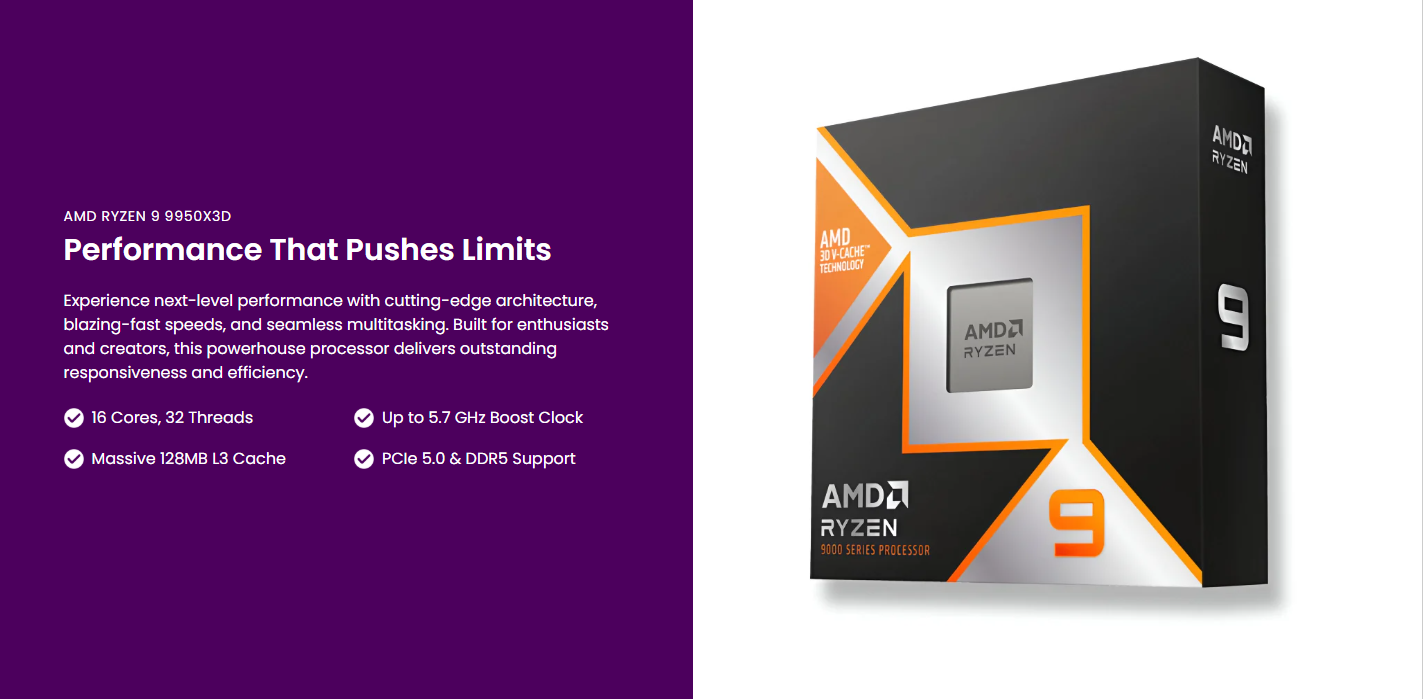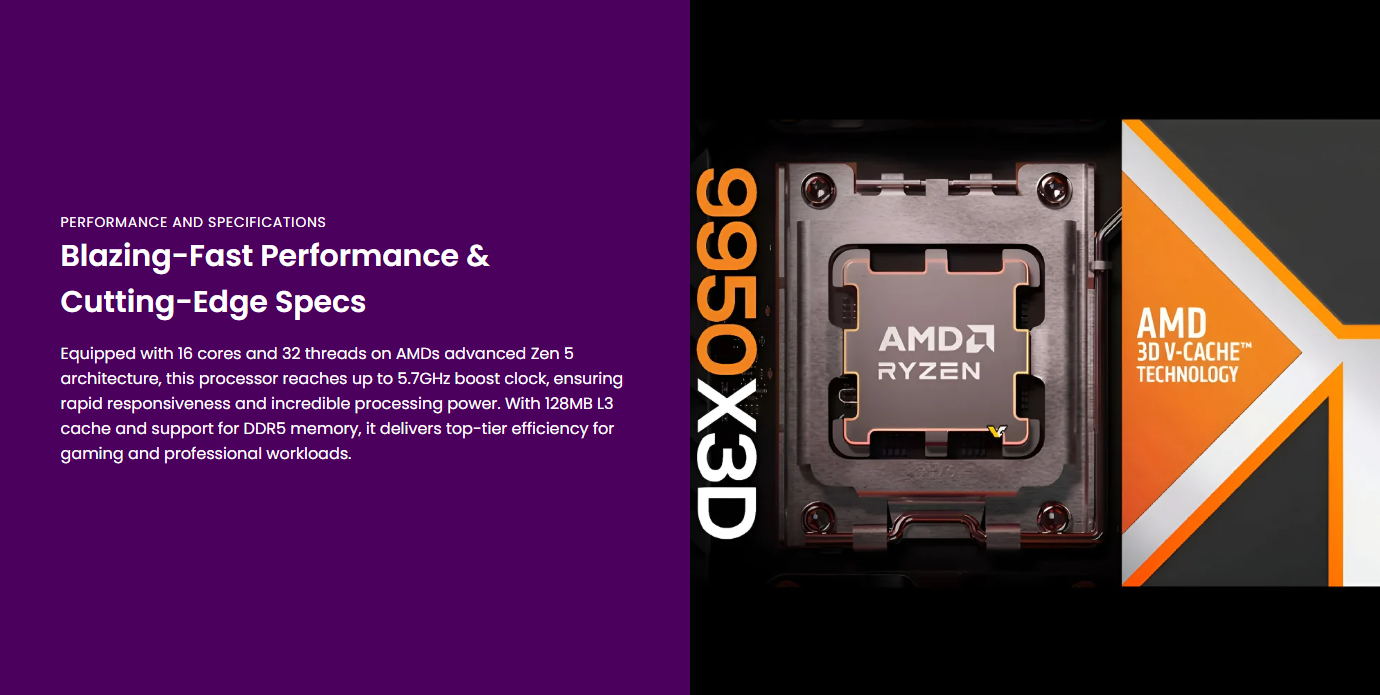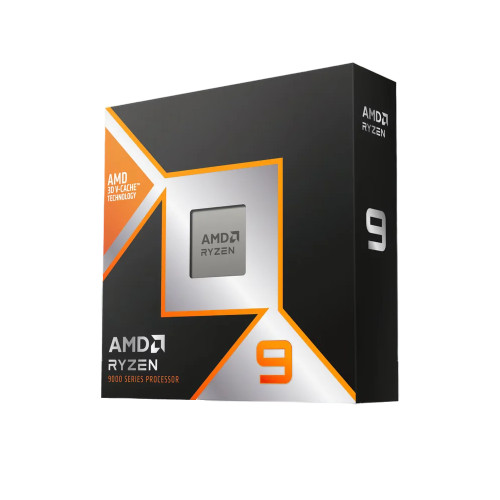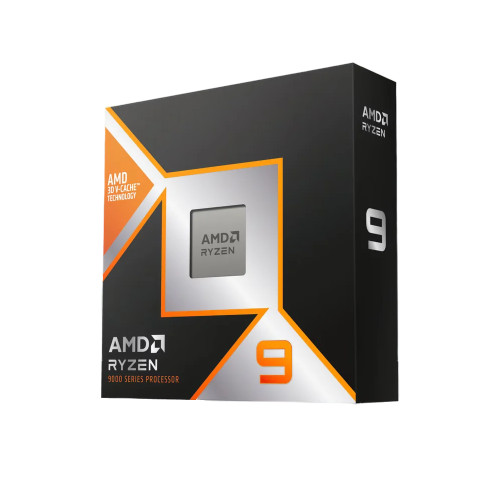POSTED: 13 March, 2025
AMD Ryzen 9 9950X3D vs. Ryzen 9 9900X3D: The Future of Gaming and Content Creation
Hold onto your seats, tech enthusiasts! The rumour mill stops now. AMD has just detonated a performance bomb, unleashing the Ryzen 9 9950X3D and 9900X3D – processors engineered to obliterate everything you thought you knew about speed. Forget incremental upgrades, we're talking about a seismic shift in CPU architecture, fueled by the revolutionary second-gen 3D V-Cache. Gaming about to hit warp speed? Content creation timelines about to shrink? Absolutely. But amidst this power surge, a critical question ignites: Ryzen 9 9950X3D versus 9900X3D – the ultimate showdown begins. Which one is your performance soulmate? Are you chasing gaming nirvana, demanding pro-level creative muscle, or simply craving unstoppable multitasking?
Prepare for a deep dive, because we're dissecting every spec, benchmark, and real-world scenario to crown the definitive Ryzen 9 X3D champion. Your journey to processing enlightenment starts now. Let's get under the hood.
Key Specs at a Glance: Ryzen 9 9950X3D & Ryzen 9 9900X3D
The AMD Ryzen 9 9950X3D is engineered as a high-performance powerhouse, featuring a 16-core, 32-thread configuration built upon the anticipated Zen 5 architecture. It boasts a base clock frequency of 4.5 GHz, enabling robust sustained performance, and is capable of boosting up to an impressive 5.7 GHz for demanding tasks. The 9950X3D is expected to incorporate a substantial cache subsystem, totalling approximately 144MB (64MB 3D V-Cache) with AMD's innovative 3D V-Cache technology to minimise latency and maximise data throughput. With a Thermal Design Power (TDP) of 170W, this processor is designed for enthusiasts and professionals who prioritise peak performance and are prepared to utilise robust cooling solutions to manage its thermal output.
The AMD Ryzen 9 9900X3D also features a 12-core, 24-thread design and is likewise expected to be based on the Zen 5 architecture, offering a strong foundation for both gaming and content creation. It operates with a base clock of 4.2 GHz and can boost up to 5.5 GHz, providing high clock speeds for demanding applications. The Ryzen 9 9900X3D is designed with a total cache of approximately 140MB (64MB 3D V-Cache) alongside 3D V-Cache technology to enhance performance through reduced memory access times. Notably, the Ryzen 9 9900X3D exhibits a lower Thermal Design Power (TDP) of 120W, indicating a focus on delivering high-end performance with greater power efficiency and potentially simpler cooling requirements compared to the 9950X3D.
Understanding the Specifications
- Cores and Threads: Ryzen 9 9950X3D is equipped with 16 cores and 32 threads while Ryzen 9 9900X3D is equipped with 12 cores and 24 threads. This signifies their ability to handle a significant number of parallel processing tasks simultaneously, making them highly capable of multitasking and demanding applications that can leverage multiple cores. The equal core and thread count suggest a similar foundation for multi-threaded performance, with differences potentially arising from other architectural and clock speed factors.
- Base and Boost Clocks: The clock speeds indicate the operating frequency of the processor. The base clock is the sustained frequency under typical load, while the boost clock represents the maximum frequency the CPU can achieve under lighter, burst workloads. The Ryzen 9 9950X3D exhibits a slightly higher base clock of 4.5 GHz compared to the 9900X3D's 4.2 GHz, and a higher boost clock of 5.7 GHz versus 5.5 GHz. These clock speed advantages for the 9950X3D suggest potentially superior performance in tasks that are sensitive to clock frequency, such as certain single-threaded applications and lightly threaded workloads.
- Cache (L2 + L3 + V-Cache): Cache memory is a crucial factor in CPU performance. It acts as a high-speed temporary storage for frequently accessed data, reducing latency and speeding up processing. Both CPUs boast substantial L2 and L3 caches, further augmented by AMD's innovative 3D V-Cache technology. 3D V-Cache stacks additional L3 cache vertically onto the CPU die, significantly increasing the total cache capacity. The Ryzen 9 9950X3D is anticipated to have a slightly larger total cache (approximately 144MB) compared to the 9900X3D (around 140MB). This larger cache, particularly the V-Cache portion, is expected to have a profound impact on gaming performance, and potentially benefit certain content creation workloads that involve handling large datasets.
- Architecture (Zen 5): Both processors are speculated to be based on AMD's next-generation Zen 5 architecture. A new architecture typically brings improvements in instructions per clock (IPC), power efficiency, and overall performance compared to previous generations. Zen 5 promises to deliver a significant uplift, enhancing the capabilities of both the 9950X3D and 9900X3D across all types of applications. While both share the same architecture, subtle implementation differences or optimizations could exist that further differentiate their performance.
- TDP (Thermal Design Power): TDP represents the maximum amount of heat the CPU is expected to generate under typical workloads, and thus provides an indication of the cooling solution required. The Ryzen 9 9950X3D has a higher TDP of 170W compared to the 9900X3D's 120W. This higher TDP suggests that the 9950X3D may consume more power and generate more heat, potentially requiring a more robust cooling solution to maintain optimal performance, especially under sustained heavy loads. The lower TDP of the 9900X3D implies greater power efficiency and potentially easier cooling requirements.
Performance Breakdown: Ryzen 9 9950X3D vs. Ryzen 9 9900X3D
The Ryzen 9 9950X3D and Ryzen 9 9900X3D, while sharing a core architecture and 3D V-Cache technology, are distinguished by key performance-defining characteristics. When comparing these processors head-to-head, subtle but significant differences emerge that cater to distinct user priorities.
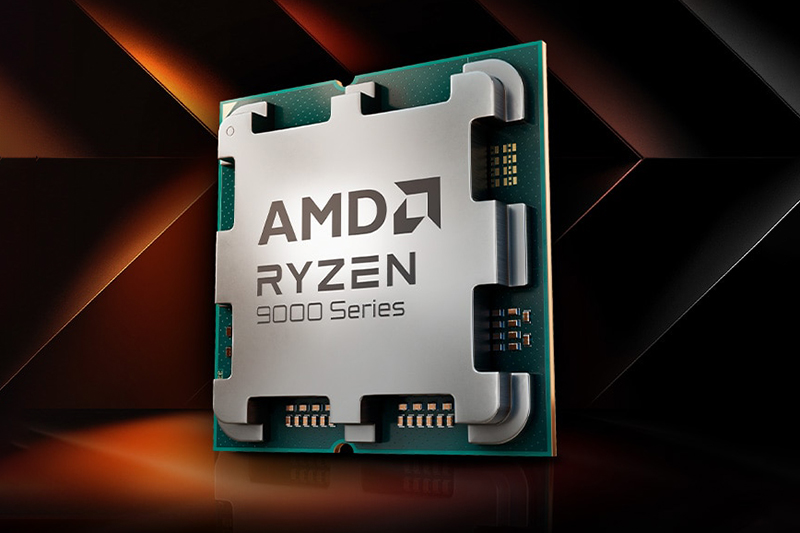 |
Clock Speed Advantage: Ryzen 9 9950X3DHigher Base & Boost Speeds: The 9950X3D outperforms the 9900X3D with a base clock of 4.5 GHz and a boost clock of 5.7 GHz. Better Performance for Frequency-Bound Tasks: Applications relying on single-threaded execution and lightly threaded workloads will benefit from the increased speed. Enhanced Responsiveness: The higher clock speeds allow for quicker task completion, making the 9950X3D ideal for performance-critical applications. |
Cache Capacity: A Minor Edge to Ryzen 9 9950X3D
Both processors are equipped with substantial L2 and L3 caches augmented by 3D V-Cache, but the 9950X3D is anticipated to have a slightly larger total cache (~144MB vs. ~140MB). While the difference is not massive, this extra cache can contribute to improved data access speeds and reduced latency, particularly in memory-intensive workloads. Games and content creation applications dealing with large datasets may see a marginal, yet measurable, benefit from the 9950X3D's slightly larger cache capacity.
Power Consumption and Thermal Design Power (TDP)
The Ryzen 9 9900X3D presents a clear advantage in power efficiency, evidenced by its lower TDP of 120W compared to the 9950X3D's 170W. This lower TDP indicates that the 9900X3D consumes less power and generates less heat under typical workloads. This has implications for cooling requirements – the 9900X3D may be easier to cool, potentially enabling quieter operation or less elaborate cooling solutions. In power-constrained environments or for users prioritising energy efficiency and quieter systems, the 9900X3D offers a more thermally and power-friendly profile. Conversely, the higher TDP of the 9950X3D suggests a greater power draw and potentially necessitates more robust cooling to maintain optimal performance, especially under sustained heavy loads.
Overall Performance Differentiation
In essence, the Ryzen 9 9950X3D is designed as the uncompromised performance leader, maximising clock speeds and slightly edging out in cache capacity, targeting users who demand the absolute best regardless of power consumption. The Ryzen 9 9900X3D, while still offering exceptional high-end performance, prioritises a balance, providing a blend of gaming and content creation prowess with a more power-efficient design. The performance differences, while potentially noticeable in benchmarks and highly specific workloads, might be more subtle in general use cases, particularly for gaming at resolutions where GPU limitations become more prominent. The choice hinges on whether users prioritise absolute peak performance and are willing to accommodate higher power consumption and cooling needs (9950X3D) or seek a more balanced and power-conscious high-end experience (9900X3D).
Gaming Dominance with 3D V-Cache
For gamers, the Ryzen 9 9950X3D and Ryzen 9 9900X3D represent a paradigm shift in CPU capabilities, largely thanks to AMD's innovative 3D V-Cache technology. This technology is not just a minor enhancement; it's a fundamental architectural innovation that directly addresses a key bottleneck in gaming performance: memory latency.
Modern games are incredibly complex, constantly streaming and processing vast amounts of data – textures, world details, AI behaviours, physics simulations, and more. Traditionally, CPUs rely on system RAM to access this data. However, fetching data from RAM introduces latency, creating delays that can limit frame rates and responsiveness, especially in CPU-intensive games or scenarios.
3D V-Cache revolutionises this by stacking a substantial amount of ultra-fast L3 cache memory directly on top of the CPU cores. This massive on-die cache acts as a high-speed data reservoir, allowing the CPU to store and rapidly retrieve frequently accessed game data, bypassing the slower system RAM for these critical operations. This dramatically reduces memory latency, allowing the CPU to feed the graphics card with data at a much faster rate, leading to significantly improved frame rates, smoother gameplay, and reduced stuttering, particularly in CPU-limited scenarios.
The second-generation 3D V-Cache, featured in both the Ryzen 9 9950X3D and 9900X3D, is expected to further refine this technology. Potential improvements include increased cache capacity, lower latency, and enhanced bandwidth, leading to even greater gaming performance gains compared to the first generation.
Ryzen 9 9950X3D: The Apex Gaming Performer
Positioned as the ultimate gaming CPU, the Ryzen 9 9950X3D is engineered to deliver chart-topping frame rates. Its slightly higher clock speeds and marginally larger cache, combined with the Zen 5 architecture and second-generation 3D V-Cache, are designed to squeeze out every last frame per second. Gamers targeting the highest refresh rates, ultra-high resolutions (1440p and 4K), and the most demanding game titles will find the 9950X3D to be the definitive choice for achieving uncompromised gaming performance. It is specifically built to minimise CPU bottlenecks, ensuring that high-end GPUs can operate at their full potential and unlock truly exceptional visual experiences.
For competitive gamers and enthusiasts who prioritise absolute peak performance and are willing to invest in the best, the Ryzen 9 9950X3D represents the pinnacle of gaming CPU technology.
Ryzen 9 9900X3D: Exceptional Gaming, Broad Appeal
While not positioned as the absolute top-tier gaming CPU, the Ryzen 9 9900X3D remains an incredibly potent gaming processor. It leverages the same revolutionary 3D V-Cache technology and Zen 5 architecture, ensuring remarkably smooth and responsive gameplay across a wide range of titles. For the vast majority of gamers, the real-world gaming experience delivered by the 9900X3D will be virtually indistinguishable from the 9950X3D in most scenarios. It provides a phenomenal high-end gaming experience, offering fluidity and responsiveness that will satisfy even demanding gamers. The Ryzen 9 9900X3D strikes an exceptional balance: delivering top-tier gaming capabilities while potentially being more accessible in terms of price and power consumption. This makes it a highly attractive option for gamers who want exceptional gaming performance but also value overall system efficiency and cost-effectiveness.
It's a superb choice for gamers playing at various resolutions, from 1080p to 4K, and for those seeking a high-refresh-rate, immersive gaming experience without necessarily pursuing the absolute maximum possible frame rates at any cost.
Content Creation & Multitasking Prowess
Beyond their gaming prowess, the Ryzen 9 9950X3D and Ryzen 9 9900X3D are also formidable contenders for content creation and demanding multitasking scenarios. Modern content creation workflows are increasingly CPU-intensive, encompassing tasks like video editing, 3D rendering, motion graphics, software development, and complex simulations. These tasks benefit significantly from high core counts, fast clock speeds, and ample cache memory – all strengths of these new Ryzen 9 processors.
With 12 cores and 24 threads, based on the advanced Zen 5 architecture, both processors are well-equipped to tackle demanding creative workloads. The high core counts enable efficient parallel processing, crucial for tasks that can be broken down into multiple simultaneous threads, such as rendering and video encoding. The architectural improvements in Zen 5 further enhance instructions-per-clock (IPC) performance, leading to faster processing across a broader range of content creation applications.
Ryzen 9 9950X3D: Peak Performance for Creative Professionals
The Ryzen 9 9950X3D, with its higher sustained clock speeds, is anticipated to offer a slight but potentially valuable performance advantage in content creation workloads that are sensitive to clock frequency. Tasks like video encoding, certain types of rendering, and real-time previews in video editing software may see faster completion times on the 9950X3D. For professional content creators who demand the absolute fastest turnaround times and whose livelihoods depend on efficient workflows, this performance edge can be significant.
It’s the processor designed for professionals who push their systems to the limit and require uncompromising performance for demanding creative applications, especially in time-sensitive projects where every second saved contributes to productivity and profitability.
Ryzen 9 9900X3D: Robust Creative Capability and Versatility
The Ryzen 9 9900X3D, while potentially slightly trailing the 9950X3D in clock-speed-dependent tasks, remains an exceptionally capable platform for content creation. Its strong multi-core performance, powered by the Zen 5 architecture, ensures smooth and efficient handling of complex creative projects. It is more than capable of handling professional-grade video editing, 3D modelling, rendering, motion graphics, and software development tasks. For many content creators, especially those who also prioritise gaming, the 9900X3D offers a superb balance. It provides the creative horsepower needed for demanding workflows while also delivering exceptional gaming performance, all within a more power-efficient and potentially cost-effective package.
It's a versatile choice for creative professionals who need a reliable and powerful workstation that can handle both demanding creative tasks and high-end gaming needs, without necessarily requiring the absolute peak performance of the top-tier model.
Which One Should You Choose?
The decision between the Ryzen 9 9950X3D and Ryzen 9 9900X3D hinges on your primary use cases and priorities. Let's break down the ideal scenarios for each processor:
Go for the Ryzen 9 9950X3D if…
- Uncompromising Gaming Performance is Your Top Priority: If gaming is your primary passion and you demand the absolute best, the Ryzen 9 9950X3D is the definitive choice. It's built to deliver the highest frame rates, smoothest gameplay, and maximum future-proofing for demanding games.
- You are a Professional Content Creator with Time-Critical Workloads: For professionals where every second counts, the 9950X3D's slight performance edge in clock speed can translate to tangible time savings in demanding creative tasks, enhancing productivity.
- Future-Proofing is Paramount for Both Gaming and Productivity: Choosing the top-tier 9950X3D ensures your system remains at the performance forefront for longer, capable of handling increasingly demanding games and applications in the future.
- Power Consumption and Budget are Secondary Considerations: If you are willing to invest in the absolute best and accommodate higher power consumption and cooling needs, the Ryzen 9 9950X3D offers uncompromised performance.
Choose the Ryzen 9 9900X3D if…
- You Seek an Excellent Balance of Gaming and Multitasking: The 9900X3D provides exceptional gaming performance alongside strong content creation capabilities, offering a versatile and powerful all-around solution.
- Value and High-End Performance are Key: The 9900X3D delivers near-flagship performance at a potentially more accessible price point, offering outstanding value for high-end gaming and creative tasks.
- Power Efficiency and Quieter Operation are Desirable: With a lower TDP, the 9900X3D offers greater power efficiency and potentially easier cooling requirements, leading to quieter system operation and reduced energy consumption.
- You are Upgrading for a Substantial Performance Boost without Extreme Core Counts: The 9900X3D provides a significant upgrade from older CPUs, offering ample performance for most users without the absolute highest core counts, making it a balanced and effective upgrade path.
Feature Comparison: Ryzen 9 9950X3D vs. Ryzen 9 9900X3D
Want to cut through the tech specs and get straight to the point? Our feature comparison table is your fast track to understanding the Ryzen 9 9950X3D vs. 9900X3D! In seconds, see a clear, side-by-side breakdown of what truly matters: cores, speed, cache, and more. Stop guessing and start knowing – effortlessly compare these powerhouse CPUs and confidently choose the perfect Ryzen 9 for your needs!
| Feature | Ryzen 9 9950X3D | Ryzen 9 9900X3D |
|---|---|---|
| Cores / Threads | 13 Cores / 32 Threads | 12 Cores / 24 Threads |
| Base Clock | 4.5 GHz | 4.2 GHz |
| Boost Clock | 5.7 GHz | 5.5 GHz |
| Cache | 144MB (64MB 3D V-Cache) | 140MB (64MB 3D V-Cache) |
| Architecture | Zen 5 (Speculative) | Zen 5 (Speculative) |
| TDP | 170W | 170W |
Final Thoughts
AMD’s Ryzen 9 9950X3D and 9900X3D mark a new era for gamers and content creators, delivering next-level performance, efficiency, and cutting-edge technology. The Ryzen 9 9950X3D dominates with unmatched gaming frame rates and lightning-fast content creation speeds, making it the ultimate powerhouse for enthusiasts. Meanwhile, the Ryzen 9 9900X3D strikes the perfect balance between performance and efficiency, offering high-end capabilities at exceptional value—ideal for those who demand versatility.
No matter which you choose, both processors redefine next-gen computing, pushing the limits of what’s possible. It’s time to stop imagining and start experiencing the future of performance.
Ready to upgrade? Explore pricing, compatibility, and exclusive deals on the Ryzen 9 X3D series at Box.
Don’t wait—unlock peak performance, build your dream setup, and game like never before!
